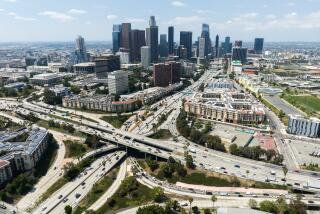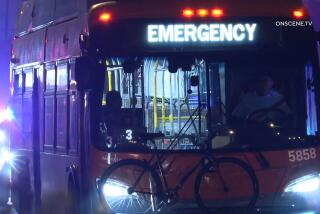On the Road to Improving Bus Service
- Share via
NORTHRIDGE — Each workday, Don Moses spends about six hours on a bus.
Moses, of Canoga Park, needs about three hours and three different buses to make it to work in West Los Angeles by about 8:30 a.m. At quitting time, his trek begins again, eventually getting him home 15 or more hours after he left.
It’s a rough routine for the 50-year-old carwash worker, but public transit is his only means of getting around.
“I just put up with it,” Moses, his Dodgers cap providing far too little shade from the sun, said while waiting for a bus last week at Parthenia Street and Tampa Avenue. “Why do buses take so long? . . . I just don’t like the service late at night. It sucks.”
Moses, who said the bus service could use improvements but is not so bad overall, is one of more than 1 million riders who the Metropolitan Transportation Authority says board buses in the region on an average weekday. Nearly 119,000 of them ride in the San Fernando Valley.
The vast majority of riders are poor and without options. Surveys show more than 75% of the bus riders do not have cars. Nearly 50% have household incomes less than $15,000.
While the MTA insists that most riders rate service as at least good, a spot survey last week showed that many must cope with smelly, grimy, often overcrowded buses that regularly arrive late and seem to take forever. Interviews showed riders split between tolerating and hating the agency.
Whatever the view, riders tonight will have a chance to share their views at a meeting designed to help the MTA reduce overcrowding, improve existing services and add new routes and more buses.
The agency promised to do all those things in an October settlement of a lawsuit alleging that massive spending on rail projects diverted funds from low-income and minority bus riders.
The meeting at 7 p.m. at Kaiser Permanente in Panorama City is expected to feature representatives for the MTA, Rep. Howard L. Berman (D-Mission Hills), Assemblyman Bob Hertzberg (D-Sherman Oaks) and the Bus Riders Union, the nonprofit civil rights group that sued the MTA seeking reforms.
Similar meetings were held in South Los Angeles and Koreatown this month and another one is scheduled in East Los Angeles on Wednesday.
“The purpose of all of this is to hear what the users of the system feel is lacking,” said Dana Woodbury, a deputy executive officer for the MTA. “I would have to say in all honesty we don’t measure up. We should be able to do better.”
The deal called for the MTA to freeze the $1.35 cash fare and the 90-cent token price for two years; increase security with more transit police; continue the sale of monthly passes for three years, cutting the price from $49 to $42, and provide 15-day passes for $21 and weekly passes for $11.
The settlement also called for the MTA to cut off-peak fares to 75 cents on some lines; add 102 buses by the end of this month, and add 50 more buses on heavily used lines in the next two years to help riders reach destinations such as medical facilities, job sites and vocational schools.
The agency added 53 buses to its fleet last year and plans to add another 53 by the end of this month, meaning it will have added 106 more buses and surpassed the minimum requirement by four buses, Woodbury said.
Transit centers being built in Chatsworth, Sylmar, Burbank and Warner Center are expected to make things move better in the Valley, MTA officials said. In addition, a so-called smart shuttle with a flexible route is planned for the northeast Valley and West Valley.
But improving the bus service is only one of many issues before the troubled MTA.
This month, the authority’s board approved a plan that delays construction of a San Fernando Valley rail line at least 10 years--perhaps even 14--while promising to improve bus service and complete the Los Angeles subway.
But seven City Council members and several lawmakers demanded that the MTA board make the cross-Valley line happen sooner. The demand is especially noteworthy since the MTA is counting on $200 million in city funds to help cover subway construction costs.
Meanwhile, federal officials have demanded that the transit agency get control of its finances and stop promising more than it can deliver. The MTA wants $100 million from Congress for subway extensions to North Hollywood and the Eastside.
As if that were not enough, MTA officials currently are in contract negotiations with labor unions representing about 6,000 bus operators, mechanics and clerical staff.
Those factors, which Woodbury acknowledged are bound to dilute the attention paid to any single issue, increase the importance of emphasizing the need for better bus service, said transit officials, riders and their advocates, such as the Bus Riders Union.
“L.A. is a city with multiple centers of activity,” said Kikanza Ramsey, an organizer with the group. “No one wants to catch a bus that comes every hour or hour and a half.”
That conclusion would get no argument from experienced riders such as Jacquelyn Temple of North Hollywood.
Temple, 49, is a student and activist who rides the buses just about everywhere she goes. Classes are at Valley College. Church is in South Los Angeles. Her post office box is in San Fernando. And her brother lives in Panorama City.
“I always carry a book,” said Temple, who on this day was flipping through pages of Terry McMillan’s “How Stella Got Her Groove Back” in between jumps from one bus to another. “That way I don’t have to be annoyed by the inevitable delays. What’s the alternative? I recognize the fact that I’m dependent on public transportation.”
Temple knows to wear large hats that shield her from the sun and that wrap around her head so that her hands remain free. The smart rider’s routine comes almost automatically to her: have exact fare, or better yet, a bus pass; have a quarter ready for a transfer so that others are not delayed; and know bus schedules in order to gauge the time spent running errands.
After picking up bus route information from an MTA customer service and ticket office in Van Nuys, Temple joined about 16 people waiting for a westbound bus. A short ride later, she exited the bus, crossed Sepulveda Boulevard and waited for a northbound bus to pick up her mail.
The MTA is quick to point out that many bus riders are satisfied with the service they receive. A recent MTA survey claimed that nearly two-thirds of all bus riders rated the MTA service as “good” or “very good.”
Last week, some Valley riders agreed. “They do an OK job,” said Rebecca Carey, 18, of Northridge, who was waiting for a bus at Reseda Boulevard and Nordhoff Street. “I think the bus drivers could be nicer. . . . They’re pretty good. They run late occasionally.”
Sergio Hernandez, who was crouched next to a mailbox for shade while he waited for a southbound bus on Sepulveda Boulevard in San Fernando, said the service is “sometimes good.” The buses often arrive about 10 to 15 minutes behind schedule, but most days that is not a big deal, he said.
“You get out of work tired and eager to get home,” said Hernandez, 38, a maintenance worker at a nearby McDonald’s restaurant. “But it’s a good service. All the drivers are very friendly.”
Several others agreed more with Moses, who is far too familiar with long waits on hard benches.
“Here’s my bus,” Moses said after many minutes in the afternoon sun. “I don’t want to miss this one.”
More to Read
Sign up for Essential California
The most important California stories and recommendations in your inbox every morning.
You may occasionally receive promotional content from the Los Angeles Times.










